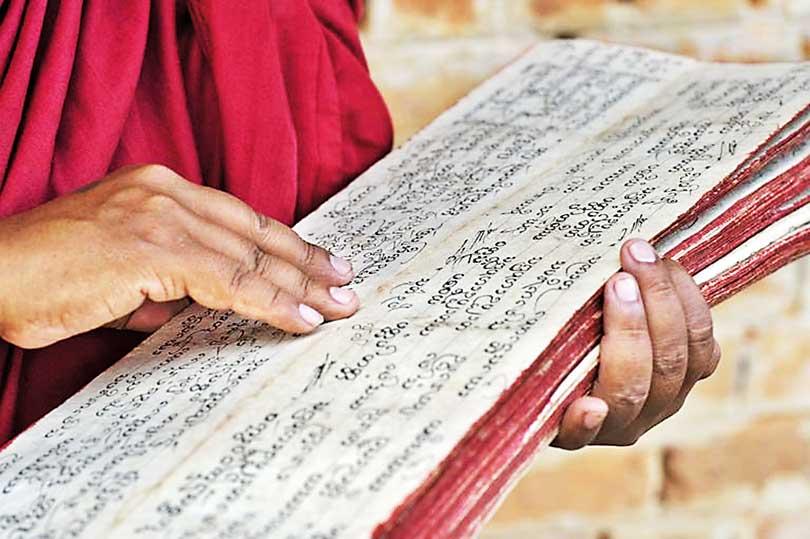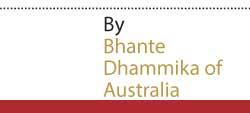Reply To:
Name - Reply Comment


It is good to know that the Pali Tipitaka has been given the recognition it deserves by being designated a part of the National Heritage. It is also fitting that the announcement of this designation has been announced by President Sirisena at Aluvihara, where the Tipitaka was first committed to writing. While the president, his retinue and the assembled guests were at Aluvihara some of them may have noticed and read the dedication stones in and around the temple because if they did it might have given them pause for thought.
In the early 1950s, the then chief prelate of Aluvihara conceived the idea of establishing an “international library” in the temple. This was during the build-up to the 2500 Buddha Jayanthi in 1956 and excitement and enthusiasm by the world’s Buddhist was electric. Considerable amounts of money were raised for the library, grandiose plans were announced, Prince Norodom Sihanouk of Cambodia laid the foundation stone, - and after all the hoopla other than erecting a building nothing else was ever done. And with good reason. The temple is outside Matale, a small rural town today, even smaller in the 50s, several of Ceylon’s universities already had fairly good libraries of Buddhist books; neither Aluvihara’s chief prelate nor any of his monks knew anything about librarianship (and never made any effort to learn it); and they had neither the competence nor the know-how to guide any scholars who might come. It wasn’t “international”, it wasn’t national, it was hardly even local. Rather, it was a genuine but utterly unrealistic dream conceived for no other reason than that there was supposedly a library at Aluvihara over 2000 years earlier.
The point of this story is that before any worthwhile project, if it is to be successful, there needs to be clear and attainable goals set and a strategy decided upon to achieve them. Then, after all the big ceremonies there has to be follow-up where the strategy to attain the goals is implemented and carried through. Has anything like this been done as part of making the Tipitaka an object of National Heritage, or is it just another empty gesture, a sop to religious and national feelings, a way for politicians to make it look that they are doing something meaningful? It need not be.
Recently Dr. Upul Wijayawardana (Daily Mirror March 20, 2019) pinpointed several of the problems in Theravada in Sri Lanka and suggested ways these could be tackled. That there are problems in how Buddhism is understood and practised and need to be rectified seems to me to be without question. But there is one thing that could be done which Dr. Wijayawardana could have included. Now that the sacred scriptures have been given National Heritage status, perhaps it’s time some effort is made to encourage people to read it and become familiar with it. If there are misunderstandings about the Dhamma, and there are, this is mainly due to the fact that people get their understanding of the Dhamma from tradition and custom rather than from the Buddha’s own words. It is true that little tracts containing the Mangala Sutta, the Metta Sutta, the SigalovadaSutta, etc. are widely available but there is more, much more to the Dhamma than this.
Efforts have been made to rectify this situation before. With the approach of the Buddha Jayanthi in the early 1950s calls were being made to make the Tipitaka available in ordinary languages. The government in Ceylon undertook to do this, but as seems that the initial enthusiasm soon slowed to a crawl and 60 years after the project started it is still not finished. But beyond this unexplained delay are other problems. Each volume of the Sinhala Tipitaka is very large and even two or three copies would be quite expensive for the average person. Then there is the problem of accessibility. I cannot read Sinhala, but monks who can tell me that the language in the translation is high Sinhala; archaic and difficult to read. Several monks have even told me that they actually find it easier to read the Pali than the old-style Sinhala. But it gets worse! Even if you were prepared to persevere and struggle to understand the language, just trying to get a volume requires time and trouble. The volumes of the Tipitaka available so far can only be had from two or three outlets in the whole country. The Bible by contrast is available in nearly every hotel room in Sri Lanka, but trying to find the Tipitaka remains a desiderata.
In the early 1950s, the then chief prelate of Aluvihara conceived the idea of establishing an “international library” in the temple. This was during the build-up to the 2500 Buddha Jayanthi in 1956
In 1939, A. P. de Zoya embarked on an ambitious project to translate the whole of the Tipitaka into plain, easily understandable Sinhala for the benefit of the ordinary person. The whole project took over 20 years and with the help of some Buddhist scholars he eventually produced 48 volumes. Realizing that few people could afford to purchase this full set he then decided to do a selection of the suttas in ten volumes but he only got as far as the first two books before his death in 1968. De Zoya shows what one person can do if they have the devotion and the determination. Curiously, his books do not seem to have attracted a wide readership, probably because of circulation problems. I rarely see any of his volumes in the bookshops.
There are several things that make any religion vibrant and healthy, and one of these is a laity well-read in the sacred literature. The Buddha was clear that he wanted all his disciples and followers to know the Dhamma well. In the Mahaparanibbana Sutta he said: “I shall not die until the monks, the nuns, the laymen and the laywomen have become deeply learned, wise and well trained, remembering the teachings, proficient in the greater and lesser doctrines, virtuous and learned; not until they are able to tell it to others, teach it, make it known, establish it, open it up, explain it and make it clear; not until they are able to refute false doctrines taught by the others and to spread the convincing and liberating truth abroad.”
Given the problems discussed above I would like to suggest several things that could be done to rectify them. A selection of several hundred suttas should be translated into modern every-day Sinhala and published in a single volume. The suttas selected should give preference to those dealing with subjects likely to be of interest to the average person; i.e. lay people. There should be explanatory notes, a glossary and a detailed index. Called the CulaTipitaka (The Small Tipitaka), it should be made available at cost price or if possible for free; generous donors could pay for reprinting it in memory of their departed loved ones. Just as importantly, it should be as easily available as possible. Every school library and public library should have a copy. Wouldn’t this be a true Dhamma-dana, wouldn’t that be a truly meaningful way of honouring the Tipitaka? Further, if an effort were made to have this Cula Tipitaka translated into English and have a copy placed in every hotel room in the country tourists who came here could go back home with just more than photos and good memories. Some might be drawn to the Dhamma.
One would have to admit that the many of the suttas are not easy to read; some are long, often due to continual repetitions. So together with CulaTipitaka another book should be published made up of extracts from the suttas, taking the best of the suttas. In this form the book could include far more material than possible in the CulaTipitaka. Other than this, such a book should have the same character.
Several decades ago a Japanese industrialist and devote Buddhist set up an organization called Bukkyo Dendo Kyokai to publish a book called ‘The Teachings of Buddha’ similar to the ones I am proposing. This project has been highly successful. The book is beautifully produced, with fine paper and binding, so far over eight million copies have been printed, it has been translated into 45 languages and it is available in thousands of hotels all around the world. Further, the book is free. Unfortunately, despite these achievements this book has several drawbacks. In the English edition at least, the languages is awkward and clumsy, the reference system is confusing, and including of both Theravada and Mahayanasutras it leaves the reader unsure and slightly confused as to exactly what Dhamma is. But while this project shows what could be done it also offers a warning that such a project as I am proposing should be done with careful and realistic forethought, considering all the options and keeping the goal always in mind – making the Dhamma available, appealing and understandable to the average person.
Great monks of the past sometimes made heroic efforts to protect and preserve the Tipitaka. Shouldn’t we make an effort to read it?